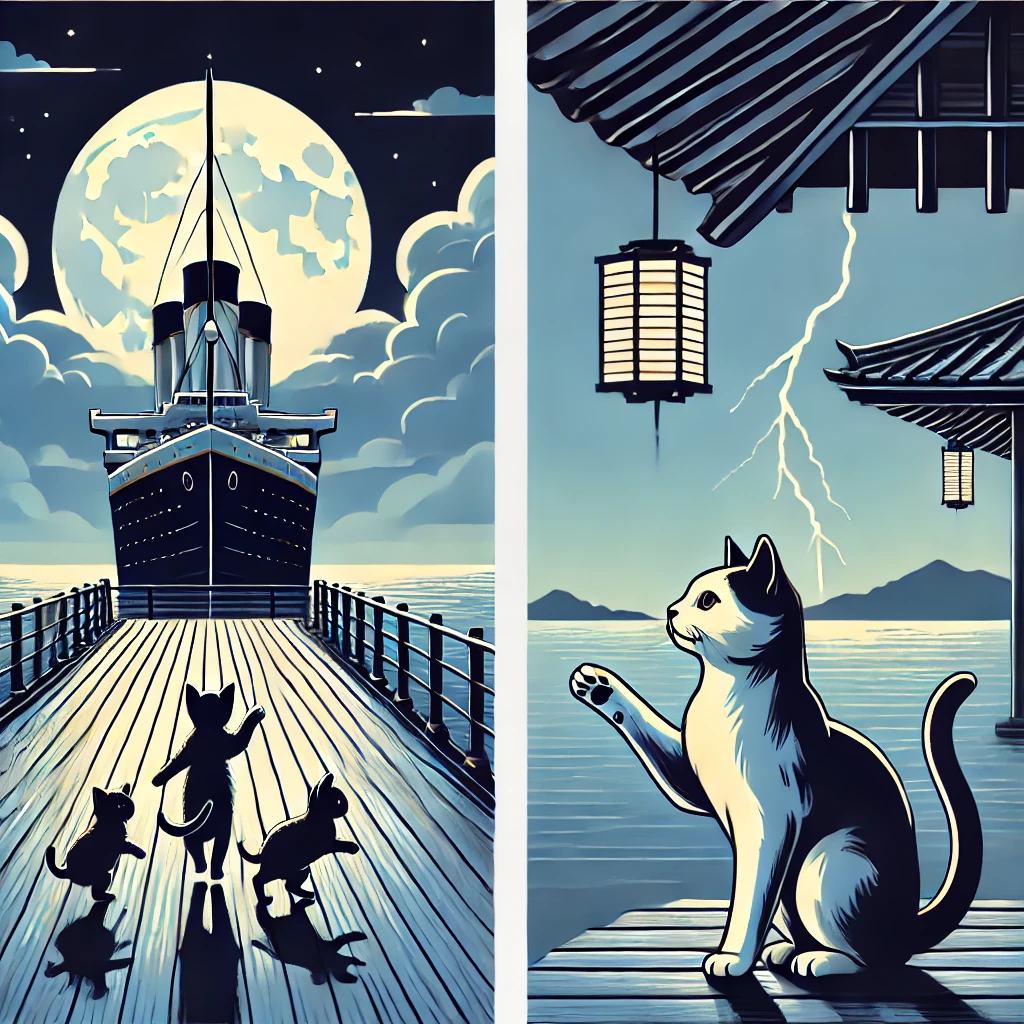Some legends sail across oceans and others echo through temple courtyards, yet the most unforgettable tales are often whispered by cats. Meet Jenny, the ship’s cat aboard the RMS Titanic, and the original maneki-neko, Japan’s beckoning cat. Separated by centuries and continents, each feline hero relied on uncanny instincts to rewrite fate when humans hesitated.
In April 1912, the Titanic gleamed like a floating palace. First-class diners clinked champagne flutes on fine china, while steerage passengers whispered dreams of America’s promise. Below decks, Jenny the tortoiseshell prowled as official rat catcher and self-declared queen of the galley. Her nightly rounds included draping over flour sacks in the pantry and pouncing on rogue crumbs that slipped off the bakers’ trays. The crew kept bells on her collar so she could never slip too far into the dark cargo hold, and the engineers joked that Jenny kept the rats in line more than any human ever could.
Just days before departure, Jenny gave birth to six kittens under a stack of clean dishware. The new family seemed safe and content, until Jenny’s whiskers began to twitch at odd hours. She paced the corridors at dawn, ears tilted toward faint bangs on the hull. She studied the rising gangplank with narrowed eyes. One evening, after a clamorous rehearsal of the ship’s band, Jenny emerged from the galley clutching a kitten by the scruff. She paraded her brood down the gangway into the cool night air, each tiny paw padding the wooden planks. Jim Hawkins, a kindly steward who had slipped her tuna scraps, rubbed his eyes to make sure it wasn’t a trick of the lantern light. Jenny’s gaze locked on the departing hull, and Jim felt a shiver of panic. He scooped up his lunch pail, followed Jenny off the deck, and tucked the kittens into a spare crate behind the dock office. By the time the Titanic slipped its moorings, Jenny sat atop that crate as still as a statue. Jim shook his head in wonder and said quietly, “That cat’s got better instincts than the captain.” Hours later, the ship met the iceberg, and history recorded its tragic end, without Jenny or Jim among the dash-encrusted survivors.
Meanwhile, in mid-Edo-period Japan, another cat was becoming the stuff of legend. The Gotokuji Temple lay at the edge of a small village, its wooden beams bleached by sun and wind. A humble priest lived there in modest poverty, tending incense and prayers with the sunrise. One afternoon, a sudden thunderstorm sent villagers scurrying for cover. The priest sheltered beneath the temple’s eaves, his robes soaked and his prayer beads slipping through damp fingers. A white cat with a single black patch on its ear appeared silently at his side. It lifted a paw in that familiar beckoning gesture – one, two, three times – inviting the priest to move from the very spot he had occupied. Moments later, lightning struck the polished stone where he had stood, sending splinters of rock across the courtyard. The priest bowed deeply to the cat and vowed that it would be honored for saving his life.
Word spread swiftly. Nearby artisans carved wooden statues of the cat in its welcoming pose and donated them to the temple. Visitors noticed that merchants who displayed these figurines enjoyed an uptick in customers and prosperity. Over decades, the maneki-neko evolved in material and meaning. White ceramic cats signified general good luck. Gold versions beckoned wealth. Black cats warded off evil spirits. Red cats promoted good health. Each nuance reflected a layer of cultural refinement, from the simple wooden charm born of gratitude to the glossy, multicolored icons gracing shop counters today.
Both Jenny’s maritime exodus and the maneki-neko’s lifesaving wave celebrate the same feline superpower: acute instinct. In Japanese philosophy, this state is called zanshin, the calm readiness that follows action. Jenny embodied zanshin on a rolling deck, sensing danger when the human officers did not. The temple cat embodied zanshin under thunderous skies, acting with perfect timing. Each taught humans that survival often hinges on seizing moments when thought yields to instinct.
These tales also carry the spirit of kaizen, continuous improvement through small, steady changes. Jenny’s legend has grown richer with each retelling, as storytellers add new details, sometimes the kittens number seven, sometimes Jim builds a cottage for his feline savior. The maneki-neko’s evolution from wooden charm to mass-market ceramic has refined the message across generations: trust intuition and invite good fortune through quiet gestures.
And there is wabi-sabi, the beauty of imperfection and impermanence. Jenny’s crooked ear and the temple cat’s chipped paw tell of narrow escapes and the passage of time. Their very flaws make the legends more human, relatable, and alive. In both cases, we find comfort not in flawless design but in the cracks that hold stories.
Modern boardrooms and design studios sometimes borrow these feline fables as leadership parables. “Be like Jenny,” executives urge, “anticipate market icebergs and evacuate our resources before the hull breaches.” “Channel the maneki-neko,” they advise, “beckon opportunity with a single confident gesture.” Workshops and seminars pepper presentations with images of cats at keys, cats by cash registers, proof that even in our data-driven world, a twitch of instinct can outpace any algorithm.
Today, maneki-neko figurines lean toward cash registers in ramen shops and tech startups alike, while Jenny’s myth prowls the internet’s hidden corners, on maritime blogs, cat meme pages, and urban legend forums. Both cats remind us that the keenest alarms come with fur and whiskers, not sirens.
So the next time your own cat fixes you with a long inscrutable stare or you feel a sudden tingle at the base of your spine remember Jenny and the maneki-neko. Pause and trust that moment of stillness before pouncing. Trust that twitch of conviction in your gut. After all, whiskers know what words cannot.
Author’s Note
No cats were harmed or even bribed in the making of this story, though one did demand an extra helping of tuna for research purposes. Whenever you face your own iceberg, pause, listen for that soft paw-step of intuition, and follow it without hesitation. Whiskers never lie.
ヒゲと知恵: タイタニックの甲板から寺の門へ
バリー・アッシュワース
伝説の中には海を越えて漂うものもあれば、寺の中庭で響き渡るものもありますが、最も忘れがたい物語は、しばしば猫たちのささやきにあります。こちらは、RMSタイタニック号の船猫ジェニーと、日本の招き猫、元祖・まねきねこ。数世代と大陸を越えて、どちらの猫も人間がためらう瞬間に、奇妙なほど鋭い本能で運命を書き換えました。
1912年4月、タイタニック号は浮かぶ宮殿のように輝いていました。ファーストクラスの食事客たちは、上質なチャイナウェアでシャンパンを乾杯し、三等客はアメリカの約束についてささやき合っていました。その甲板下で、ジェニーはトーティシェル(縞模様)の猫として公式のネズミ捕り役、そして自称ギャレーの女王として徘徊していました。彼女の毎晩の巡回には、食料庫の小麦粉の袋に寝そべったり、パン職人のトレーからこぼれたパン屑をジャンプして捕まえたりすることが含まれていました。乗組員は彼女の首輪に鈴を付けて、暗い貨物室にあまり遠く行かないようにしていました。そして、エンジニアたちは冗談で「ジェニーは、人間ができない以上にネズミを統制している」と言っていました。
出発の数日前、ジェニーはきれいな食器の山の下で六匹の子猫を産みました。その新しい家族は安全で満ち足りているように見えましたが、ジェニーのヒゲが妙な時間にピクピクと動き始めました。彼女は夜明けに廊下を歩き、耳をわずかな衝撃音に向けて傾けました。彼女は上がる桟橋をじっと見つめました。ある晩、船のバンドの大きな練習後、ジェニーはギャレーから子猫を首を掴んで出てきました。彼女はその小さな家族を冷たい夜風の中、桟橋に沿ってパレードさせました。ジム・ホーキンスという親切なスチュワードは、彼女にツナの切れ端を渡していたのを思い出し、目をこすってそれがランタンの光のトリックでないことを確認しました。ジェニーの視線は出発する船体に固定され、ジムは恐怖のひとしずくを感じました。彼は昼食のかごを抱え、ジェニーに続いて甲板を降り、子猫たちをドックオフィスの裏の空き箱に入れました。タイタニック号が船縁を離れるとき、ジェニーはその箱の上に静かに座っていました。ジムは驚きながら首を振り、「あの猫は船長より直感がいい」とつぶやきました。数時間後、船は氷山と衝突し、歴史はその悲劇的な終わりを記録しましたが、ジェニーもジムもその時の生還者の中にはいませんでした。
その頃、江戸時代の中期、日本では別の猫が伝説の一部になっていました。ごとくじ寺は小さな村の端にあり、その木の梁は日光と風に漂白されていました。そこには貧しい僧侶が住んでいて、朝日とともにお香と祈りを捧げていました。ある午後、突如として雷雨が村人たちを避難させました。僧侶は寺の軒下に避難し、衣服は濡れ、祈りの数珠はしずくで滑り落ちました。その時、耳に黒い斑点が一つだけある白い猫が静かに現れました。その猫は前足を上げて、あのよく知っている「招き」動作を行いました—一度、二度、三度—その猫は僧侶にその場を移動するように招きました。ほんの数秒後、雷がその僧侶が立っていた磨かれた石に落ち、岩の破片が中庭に飛び散りました。僧侶は深く頭を下げ、命を救ってくれたその猫に感謝し、永遠にその猫を敬うことを誓いました。
その噂はすぐに広まりました。近くの職人たちは、その猫が招く姿を模した木製の像を彫り、それを寺に奉納しました。訪れる人々は、その像を飾った商人たちが顧客の増加と繁栄を享受しているのを見ました。何十年も経つうちに、まねきねこの進化は素材と意味を変えました。白い陶器の猫は一般的な幸運を象徴し、金色は富を、黒猫は悪霊を追い払い、赤猫は健康を促進するとされました。これらの細かなニュアンスは、感謝の気持ちから生まれたシンプルな木製のお守りから、今日の店頭に並ぶ光沢のあるカラフルなアイコンまで、文化的な洗練を反映しています。
著者の注記
この物語の制作において、猫は傷つけられたり、賄賂を受け取ったりしていませんが、ある猫は調査目的でツナをもう一皿要求したことがあります。もしあなたが氷山に直面したとき、少し立ち止まり、その直感のやわらかな足音を聞き、それに迷わず従ってください。ヒゲは決して嘘をつきません。


Leave a Reply